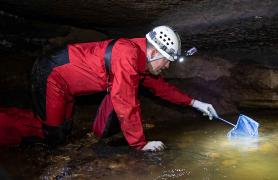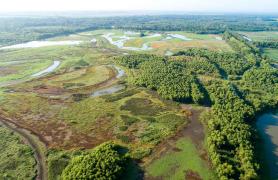
High on a bluff overlooking the Salt River near Santa Fe sits a piece of ground that means a lot to my family. It was purchased by my great-grandfather some seven decades ago, and the cabin he built there has been a hub for generations of time well-spent outdoors. It has produced countless memories and hunting and fishing opportunities. But we’ve discovered another of its precious exports in recent years — little amber-colored jars of all-natural maple syrup.
Of course, the end product takes some work, but the process is fairly simple and with a modest cost in start-up equipment, maple sugaring is a fun and accessible way to be out in nature and share a bit of that place with family and friends who are lucky enough to receive a jar.
It’s easy to imagine my great-grandpa Harry smiling at the new annual tradition — a time to get together in a place we love, with the potent and delicious smell of boiling maple sap in our noses.
A Tradition Begins
Harry’s son, my grandpa Bud Bartold, was the first in our family to get interested in syrup making after noticing an abundance of sugar maples in the steep country there. He bought taps and bags for sap collection and built a fire-brick oven, or evaporator, for boiling the sap. He’s since turned the bulk of responsibility over to the younger folks, namely his nephews Mike and Jeff Bartold, and anyone else who wants to get involved.
This past year we tapped in late February after a cold snap had finally given way to sunnier days. After taking inventory and cleaning up our gear, we spent a day walking the property and the neighboring ones where permission had been granted to tap, taking time to assess the health and maturity of each tree before drilling a hole, placing a steel tap, and hanging a collection bag from each. A highlight of this part of the process was checking back to see how much sap had accumulated.
We returned to the cabin that Friday afternoon for a weekend of boiling, a fairly long procedure that requires plenty of attention to the fire and level of sap in the pan. The first batch was complete Saturday morning in time for samples to be handed out as the rest of the family arrived.
A Bubbling Business
Like many sugaring operations in Missouri, ours is a small one, but we are able to tap a few dozen trees, and ended up with about 100 gallons of sap this past year that yielded 2.5 gallons of syrup.
There are others in the state that yield hundreds of gallons of syrup, using huge networks of tubing, large holding tanks, and reverse osmosis systems to reduce boiling time. The products of these operations can likely be found in your local farmer’s markets.
John Stolwyk, founder of the Missouri Maple Syrup Initiative, a website dedicated to the promotion and advocation of the hobby, has visited nearly two dozen sugaring operations in Missouri, large and small.
He estimates that 1,500 to 2,000 gallons of syrup are produced each year in the state.
“There are those that make it and sell it, and those that are hobbyists, and a lot of it goes on in the middle of nowhere and it’s for private consumption, and nobody really knows about it,” Stolwyk said. “It’s just a family tradition and this is what they do in the winter.”
Stolwyk is an avid syrup maker himself and believes Missouri’s production of maple syrup could increase tenfold in the next 10 years as more people learn about the resource.
“There’s a lot of forests in Missouri where sugar maples are dense enough to warrant tapping and could even become a business for a landowner,” he said.
For those wishing to get involved in syrup making, Stolwyk says start small, do your research, and even try to visit an experienced syrup-maker to see how it’s done.
The Process
Maple sugaring is a practice old as time and can be very simple with the right equipment and good timing. Nights with below-freezing temperatures followed by warm sunny days cause movement of sap laterally through the tree as temperatures fluctuate, the way blood is transported in the human body. Lines of sap will sometimes already be visible where birds or insects have done their own drilling for the nutrients.
Positive ID
Sugar maples can be hard to identify in the winter but close attention to the texture of bark, which is light gray and scaly or “furrowed,” can give them away. They can grow up to 100 feet tall, with a large, rounded crown, and mainly occur in moist to dry upland forests, in steep country, and near streams.
Step by Step
It is important to keep the health of the tree in mind when choosing which ones to tap. A mature tree, with a diameter of at least 10 inches, is best. Larger specimens may be able to support up to three taps in a single season according to MDC’s Guide to Backyard Maple Sugaring (available online at short.mdc.mo.gov/ZJW).
A shallow hole, 1.5 to 2 inches, is drilled some 4 feet from the base of the tree. A 5/16-inch bit is most often used but this will depend on the width of your taps. Maintain a clean and steady motion when drilling and try to keep the area clear of debris. Cleaning the drill bit after each use can help to avoid the spread of disease from tree to tree. Avoid dead or rotten portions.
After inserting a tap, otherwise referred to as a spile, a bag or bucket should be hung or placed below, and time allowed for sap to accumulate. Tube systems can also be used for collecting large quantities or where access is difficult. Keep in mind that sap can go bad if not cooked, frozen, or refrigerated within 72 hours.
At about 3 percent sugar content, 40 gallons of sap will produce 1 gallon of syrup, which is around 67 percent sugar, so have plenty of sap ready to go. Preheating before adding to a running boil can help to maintain a more constant temperature. Although the bulk of boiling is most often done over firewood, finishing each batch is easiest with a propane stove for added heat control. It is beneficial at this point to have tools such as a candy thermometer or hydrometer, which measures liquid density. Finished syrup has a temperature of 219 degrees F. It is often said that when the entire surface of the batch has bubbled, it is complete.
You are now ready to filter and jar your syrup for a year’s worth of pleasure.
Then this episode is for you! January and February are great times to get outdoors and taste one of the forest’s sweetest gifts — maple syrup. Nature Boost host Jill Pritchard talks with Rockwoods Reservation’s Amy Wilkinson to learn how to tap sugar maple trees to make delicious syrup.
































Also In This Issue

One county’s fight over the fate of a rare fish

Wetland conservation efforts identify bottomland ecological functions
And More...
This Issue's Staff
Editor - Angie Daly Morfeld
Associate Editor - Larry Archer
Photography Editor - Cliff White
Staff Writer - Kristie Hilgedick
Staff Writer - Joe Jerek
Staff Writer – Dianne Van Dien
Designer - Shawn Carey
Designer - Marci Porter
Photographer - Noppadol Paothong
Photographer - David Stonner
Circulation - Laura Scheuler






















